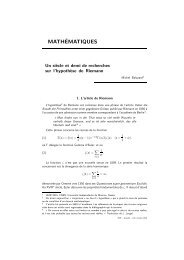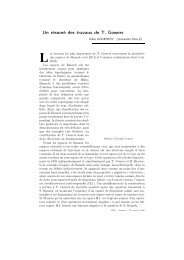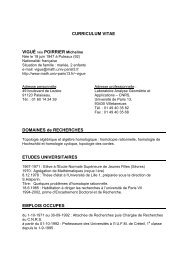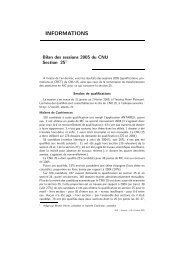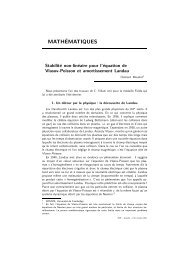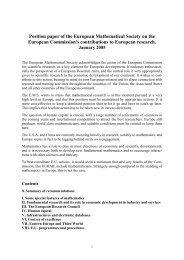EN HOMMAGE`A THIERRY AUBIN - Publications de la SMF
EN HOMMAGE`A THIERRY AUBIN - Publications de la SMF
EN HOMMAGE`A THIERRY AUBIN - Publications de la SMF
You also want an ePaper? Increase the reach of your titles
YUMPU automatically turns print PDFs into web optimized ePapers that Google loves.
76 J.L. KAZDAN<br />
Equation (1) has the form<br />
(2) −∆u + cu = hu α ,<br />
with α > 1. Given c and h one seeks a positive solution u. Integrating this<br />
equation, since u > 0, we get a condition re<strong>la</strong>ting h to the sign of c. For instance,<br />
if c > 0, then h(x) must be positive somewhere. The three cases c > 0, c = 0,<br />
and c < 0 are remarkably different.<br />
Case 1 : c > 0 . Here the size of the exponent α is important. In equation (1),<br />
α = N − 1, where N = 2n/(n − 2) is the critical case of the Sobolev embedding<br />
of H1 in LN. Aubin realized that <strong>de</strong>termining the best constant in the Sobolev<br />
inequality was fundamental. In [1] he found the smallest constant B such that the<br />
Sobolev inequality<br />
u q p B q ∇u q q + Au q q<br />
holds for all u in H q<br />
1 , with some constant A(B) in<strong>de</strong>pen<strong>de</strong>nt of u. Here p−1 =<br />
q −1 − n −1 with 1 q < n. In the application to (1), q = 2 so p = 2n/(n − 2)<br />
which is exactly the constant N.<br />
In a subsequent paper [2], he found that if u satisfies additional natural orthogonality<br />
re<strong>la</strong>tionships, then the best constant B can be lowered.<br />
He used these best constants to give basic information into when one can solve<br />
equation (1).<br />
Case 2: c < 0 . In this case the size of the exponent α > 1 is not important. A<br />
necessary condition is that <br />
h dx < 0, so h(x) must be negative somewhere. It is<br />
M<br />
easy to show that if h(x) < 0 everywhere then one can always solve (2). However<br />
in [3] Aubin and S. Bismuth, building on earlier work of Ouyang, Rauzy, Vasquez<br />
and Veron, gave important results on how the set where h(x) ≥ 0 and the size<br />
of h there influence the solvability of (2).<br />
For the two dimensional case, n = 2, Aubin obtained sharp inequalities analogous<br />
to the Sobolev inequalities. He used these to prove simi<strong>la</strong>r results for prescribing<br />
the Gauss curvature in this case.<br />
References<br />
[1] Aubin, Th., “Problèmes isopérimétriques et espaces <strong>de</strong> Sobolev.” J. Differential Geometry,<br />
11 (1976), n o 4, 573–598.<br />
[2] Aubin, Th., “Meilleures constantes dans le théorème d’inclusion <strong>de</strong> Sobolev et un théorème<br />
<strong>de</strong> Fredholm non linéaire pour <strong>la</strong> transformation conforme <strong>de</strong> <strong>la</strong> courbure sca<strong>la</strong>ire.” J. Funct.<br />
Anal. 32 (1979), n o 2, 148–174.<br />
[3] Aubin, Th.; B., Sophie, “Courbure sca<strong>la</strong>ire prescrite sur les variétés riemanniennes compactes<br />
dans le cas négatif.” J. Funct. Anal. 143 (1997), n o 2, 529–541.<br />
<strong>SMF</strong> – Gazette – 121, juillet 2009






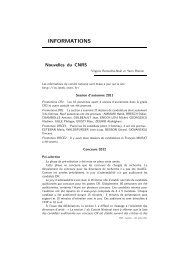
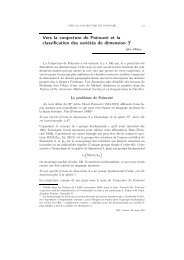
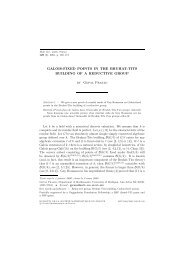
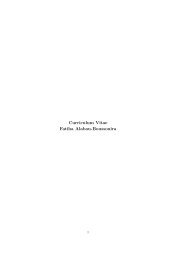
![Conclusions du colloque [24 janvier 2007] - Publications de la SMF](https://img.yumpu.com/48345829/1/184x260/conclusions-du-colloque-24-janvier-2007-publications-de-la-smf.jpg?quality=85)

